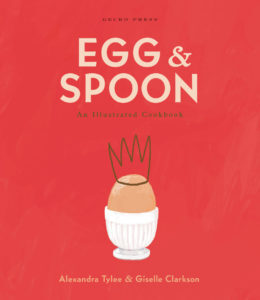 Egg and Spoon is a new cookbook from Alexandra Tylee but unlike her other cookbooks this is one for children—and adults—and instead of food photography it is beautifully and playfully illustrated by Giselle Clarkson.
Egg and Spoon is a new cookbook from Alexandra Tylee but unlike her other cookbooks this is one for children—and adults—and instead of food photography it is beautifully and playfully illustrated by Giselle Clarkson.
During lockdown in New Zealand once the cookbook was finished, Alexandra and Giselle sat down over Zoom and interviewed each other. This is the first part of the interview where Alexandra interviewed Giselle. For the second part of the interview where Giselle interviews Alexandra, see here on our blog.
Alexandra: What did you like cooking as a child, did you have a favourite dish?
Giselle: The thing I remember the most is a chocolate cake from the Martinborough Cookbook – one of those old–fashioned Women’s Institute type cookbooks. The chocolate cake recipe was a staple in our house. The best part was you had all the butter and sugar and dry ingredients and then you got to add a cup of milk, and it turned into soup as you stirred it. The milk got more and more chocolatey, a gloopy mixture, and that’s when you wanted to eat it out of the bowl.
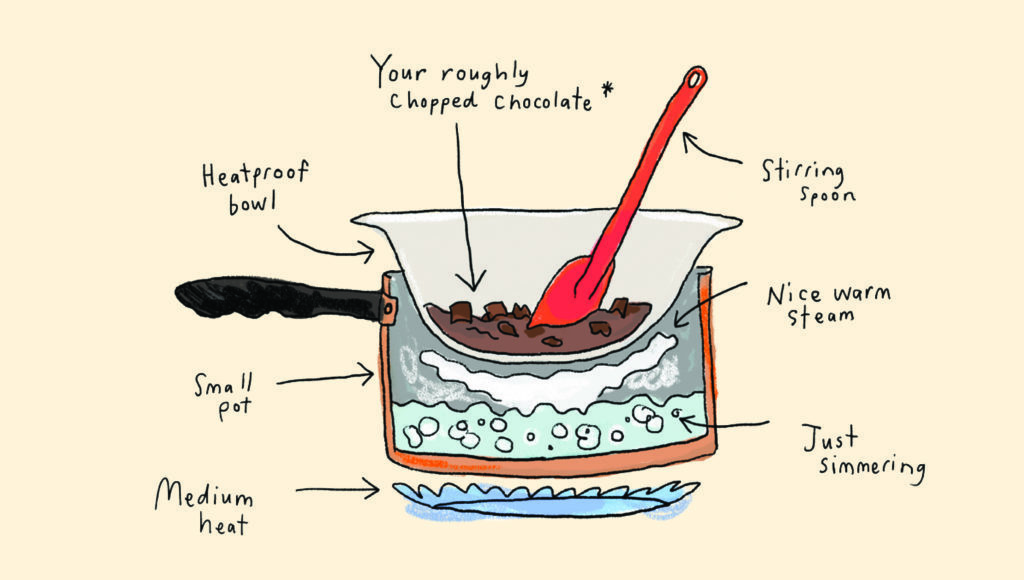
How to melt chocolate from Egg & Spoon
Did you spend a lot of time drawing when you were a child?
A lot. I wasn’t a toy kid. I didn’t have much of an interest in toys or dolls. I was much more interested in making stuff. I would make things out of anything I could find. Sticks and leaves or bits of rubbish, cardboard tubes or anything. And a lot of drawing.
Did you study Art at school?
Art was by far my favourite subject. I took as many Art subjects as they’d let me take and then left High School after Sixth Form so I could go to study Fine Art at Canterbury.
Photography was my major, and our tutor was Glenn Busch. He placed a lot of importance on educating yourself about the world. He thought you couldn’t take a good photograph unless you understood the context. That’s something I still think about. And there was such a focus on composition. What are you including and what aren’t you; always be aware of everything within the frame; nothing’s ‘just in the background’.
When did you start doing more illustrating?
A few years after I finished University. I was quite over it, having done four years of Fine Art and also not really knowing how to get a job in art. So I did a bunch of other stuff. I went and lived on Raoul Island in the Kermadec Islands for six months, working for DOC, which was incredible. It was like living in paradise with five other people. Then I did forestry work – in pine forests, measuring trees – and odd jobs in shearing sheds – sweeping wool. And then that was over, and I didn’t have a job, and I started drawing for fun again for the first time in years.
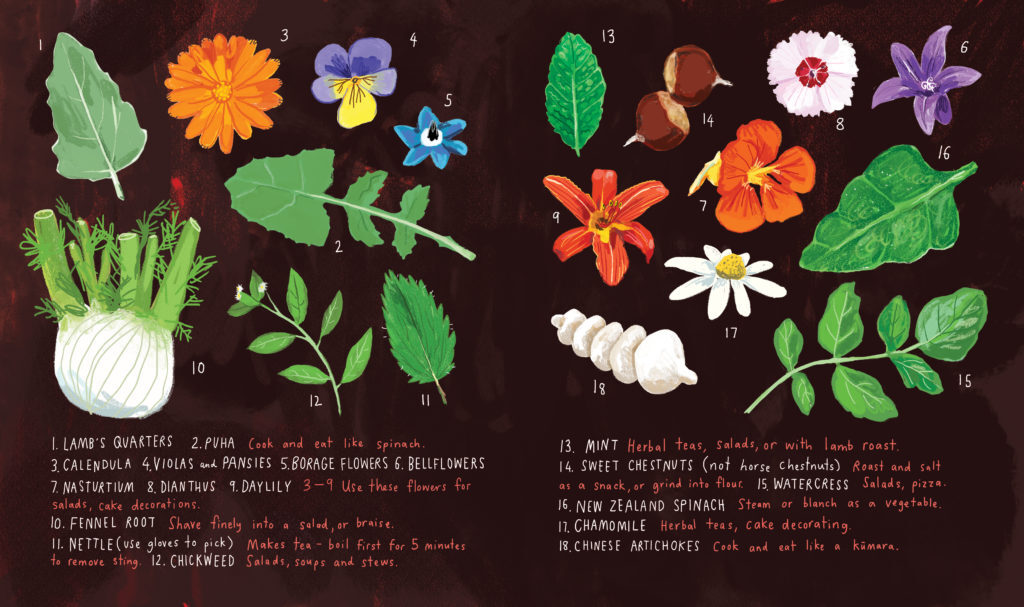
I was just getting back to what I enjoyed when I was a kid. And it finally occurred to me that could actually be a job. I started selling prints first. Once I had a portfolio, I started getting small illustration commissions, and it built from there. Little things for the Forest and Bird children’s magazine led to work with the School Journal and that led to my first job for a book.
Do you get the idea in your head first or do you just start drawing then it comes?
The idea is in my head, almost fully formed but not quite. Sometimes I start drawing and then I realise that it’s not coming out right. When I was five or six years old, I remember being so annoyed that I had this picture of a guinea pig in my head, a photorealistic guinea pig, and I was trying to draw it with felt pen. I was so mad that I couldn’t get down on paper what I had in my head.
But then you must have learned to translate that, or did it just come?
I think I just upskilled a bit. And also adjusted my expectations. It’s more about using my drawing to communicate the feeling or the vibe of something in a way that can make people understand it more than a photo would. So trying to get a liveliness or a feeling or a movement. Also I’m really impatient. I have the idea and I just want to get it down. My style has developed as a consequence of my impatience.
I’m incapable of keeping a sketchbook, because once something’s down on paper, that’s it for me, I want to move on to the next thing. I do keep a book on me always for taking notes, but I take notes rather than draw things. I’ll write a bullet point sentence of something that I’ve noticed, a combination of colours that I liked, or something I saw happening. That’s enough, and I can go back and draw it later.
I do a lot of fiddling around though – that’s what I like about working digitally. I do the sketch on the screen and then I can play with the composition or colours by shifting it around on the page. Or I’ll make the texture for the background and then play with the colour slider.
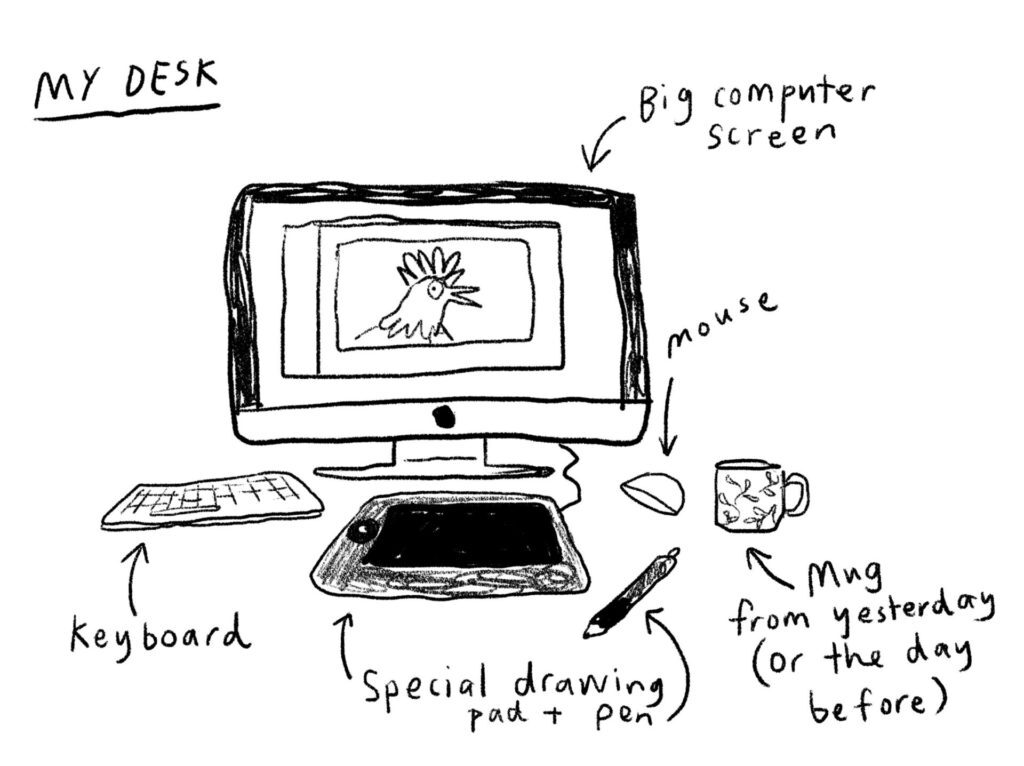
Have you always illustrated digitally?
Yeah and I think maybe that’s part of why I can’t keep a sketchbook because doing it digitally is just how I work. I bought my first drawing tablet when I was twelve. It’s what I learnt with, it’s what I adapted to, so it comes very naturally.
Do you have a favourite drawing in Egg and Spoon?
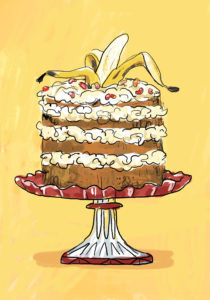
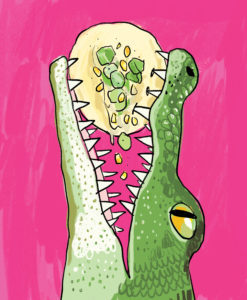 There’s probably a couple. The banana cake is one of my favourites because for me the whole image is represented by the action of putting the banana in the top. I really want to make that cake just so I can get the banana and go plerp… that would be so much fun.
There’s probably a couple. The banana cake is one of my favourites because for me the whole image is represented by the action of putting the banana in the top. I really want to make that cake just so I can get the banana and go plerp… that would be so much fun.
And the alligator and the taco.
Do you have a colour palette you like working with?
If I was making the images for Egg and Spoon entirely without guidance, I probably would have tended towards more blues and greens—colours like the sky and the sea, because that’s where my own colour palette comes from. But it wasn’t a struggle to not use those colours, I didn’t feel restricted. I had a note by my computer screen with the colours from the brief: red, pink, summer orange, gold, paperbag brown, no black. The colours make a feeling and you take that feeling and turn it into a picture. And they’re delicious colours. They make food look good. I hope I’ve made it all look really delicious!

For me, it couldn’t have been better. My other cookbooks have been photographed and I’ve styled them, so I’ve had a lot of control. For this book, it was exciting seeing something I’ve done move away from what I initially thought and become bigger and better. And it’s just fun! I showed a few pictures to someone recently and they said, that looks such fun. That’s great, isn’t it, because that’s what we want it to be – that’s the whole point of it.
I couldn’t ask for better. That’s exactly the sort of reaction I want.
Egg and Spoon is a beautiful illustrated cookbook for children—and adults—that celebrates imagination, confidence and the fun of cooking. It is now available in Australia and New Zealand wherever you buy or consume your books and on our website.
Want to hear more from Gecko Press? Every month we send out a newsletter with all of our latest blog articles, activity sheets, and sometimes a competition too! Sign up to our mailing list here.

